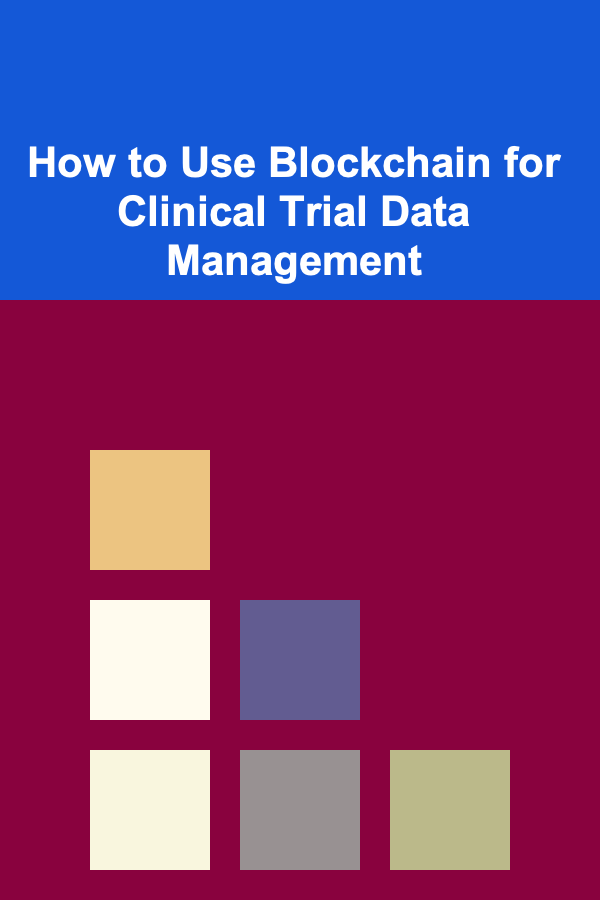
10 Tips for Using Your Project Management Planner for Remote Teams
ebook include PDF & Audio bundle (Micro Guide)
$12.99$8.99
Limited Time Offer! Order within the next:

Managing remote teams can be challenging, especially when it comes to keeping track of tasks, deadlines, and communication. However, with the right approach and tools, the process can be much smoother. A project management planner can be a game-changer in helping remote teams stay organized, productive, and collaborative. In this article, we will dive into 10 essential tips for using your project management planner effectively for remote teams.
Choose the Right Tool for Your Team's Needs
The first step in effectively managing remote teams is choosing the right project management tool. With so many options available, it's important to find one that aligns with your team's specific needs. Tools like Trello, Asana, Monday.com, or Jira each offer unique features that cater to different workflows. When selecting a tool, consider the following:
- Collaboration Features: Does the tool allow real-time collaboration? Features like comment sections, file attachments, and @mentions can foster better communication.
- Task Management: Does the tool support clear task assignment, deadlines, and priority levels?
- Integrations: Does the tool integrate with other tools your team already uses, such as Slack, Google Drive, or GitHub?
Take time to evaluate the options, and choose a tool that will fit into your team's existing processes.
Centralize Communication within the Planner
Remote teams often struggle with fragmented communication across emails, chats, and video calls. A project management planner can centralize all communication within one platform, which reduces the need to switch between multiple tools.
- Incorporate Discussion Boards: Use features like comment sections within tasks or boards for ongoing discussions about specific projects.
- Set Up Notifications: Ensure all team members are notified when there's an update on a task, whether it's a comment, file upload, or deadline change.
By centralizing communication, you'll minimize miscommunication and ensure everyone is on the same page.
Clearly Define Roles and Responsibilities
One of the major benefits of using a project management planner is that it allows you to clearly define roles and responsibilities for every team member. This is crucial for remote teams where face-to-face interactions are limited.
- Assign Tasks Clearly: Make sure every task is assigned to a specific team member, and make the responsibility clear. Avoid any ambiguity by being specific about what needs to be done.
- Set Expectations: Each team member should know what's expected of them, including deadlines, quality standards, and collaboration expectations. Include these details within the task descriptions.
Clear roles and responsibilities help eliminate confusion and ensure that all tasks are handled efficiently.
Track Progress with Milestones and Deadlines
For remote teams, staying on track can be difficult without the ability to check in physically with your team. A project management planner helps you keep track of deadlines and milestones, ensuring that everyone stays aligned with the timeline.
- Set Milestones: Break down larger projects into smaller, manageable milestones. This helps the team stay focused on short-term goals and makes progress more measurable.
- Use Deadlines: Always include deadlines for tasks and projects. Timely delivery helps ensure the team remains motivated and accountable.
Regularly checking in on milestones and deadlines helps keep projects moving forward and prevents tasks from slipping through the cracks.
Implement a Structured Workflow with Templates
Consistency is key when managing remote teams. Project management planners often offer templates for common workflows, which can help your team stay organized and on track.
- Use Pre-built Templates: Tools like Trello and Asana offer templates for everything from simple to complex workflows. These templates can be customized to suit your team's needs.
- Create Custom Templates: If you find yourself using a specific workflow repeatedly, create your own templates for recurring projects. This can save time and ensure consistency across projects.
Structured workflows streamline processes and make it easier for remote teams to follow a repeatable, efficient pattern.
Set Up Clear Communication Protocols
Effective communication is essential for remote teams. A project management planner can help set up clear communication protocols to ensure your team stays informed.
- Regular Updates: Encourage team members to update the project management planner regularly, whether it's updating task status, leaving comments, or sharing files.
- Defined Meeting Times: Use your planner to schedule weekly or bi-weekly check-ins to discuss project updates, blockers, and priorities.
- Clear Channels: Specify which communication channels should be used for different types of communication (e.g., Slack for quick messages, email for formal updates).
By having a set protocol, you can ensure smoother communication and avoid confusion about where and how to discuss project details.
Encourage Collaboration and Transparency
Collaboration can be challenging for remote teams, as people often work in isolation. A project management planner can help bridge this gap by fostering collaboration and transparency.
- Shared Boards: Make sure project boards are accessible to all team members, so everyone can see the progress and contribute when needed.
- Collaborative Tools: Use features like shared file storage, document collaboration, and team comment threads to enhance collaboration.
Transparency fosters trust within the team, and collaboration tools make it easier for everyone to contribute, regardless of their location.
Use Reporting and Analytics to Monitor Team Performance
A key advantage of using a project management planner is the ability to generate reports that provide insights into your team's performance. These insights can help you identify potential issues and optimize workflows.
- Progress Tracking: Use the planner's reporting features to track the progress of tasks and projects. This can give you an overview of how well the team is meeting deadlines and goals.
- Identify Bottlenecks: Reports can help you spot delays or bottlenecks in the process. This allows you to take corrective action before the issue grows.
Regular monitoring ensures that the team stays on course and that any issues are addressed promptly.
Encourage Feedback and Continuous Improvement
One of the best ways to improve the efficiency of a remote team is through regular feedback. A project management planner can help you collect feedback from team members and make necessary adjustments to improve workflow.
- Post-Project Reviews: After completing a project or milestone, use the planner to collect feedback from team members on what worked well and what could be improved.
- Iterative Improvements: Use feedback to make iterative improvements to your processes. Adjust task assignments, deadlines, and workflows based on lessons learned.
Continuous improvement helps teams stay agile and evolve based on their experiences, making them more effective in the long term.
Maintain a Work-Life Balance for Remote Teams
Remote teams can often struggle with maintaining a healthy work-life balance due to blurred lines between home and work life. A project management planner can help you manage this by setting boundaries and prioritizing well-being.
- Task Prioritization: Help team members prioritize their tasks to avoid burnout. Focus on high-impact tasks and allow flexibility where possible.
- Encourage Breaks: Set reminders for team members to take regular breaks, especially during long projects or tight deadlines.
- Respect Boundaries: Use the planner to define working hours and respect personal time. Avoid assigning tasks after hours unless absolutely necessary.
Promoting a balanced work-life environment is key to maintaining long-term productivity and team morale.
Conclusion
Using a project management planner effectively is crucial for managing remote teams. It not only helps with task management and communication but also improves transparency, collaboration, and team performance. By following these 10 tips, you can ensure that your remote team remains organized, productive, and motivated.
Choose the right tools, create clear workflows, track progress, and always encourage feedback. With the right approach, a project management planner can become an indispensable part of your team's success.
Reading More From Our Other Websites
- [Rock Climbing Tip 101] Climbing on a Tight Budget: DIY Training Routines and Home-Made Holds
- [Organization Tip 101] How to Store Tools for Mixed Media Projects
- [Organization Tip 101] How to Organize a Group Study Session Effectively
- [Personal Financial Planning 101] How to Celebrate Financial Milestones Without Overspending
- [Organization Tip 101] How to Use Technology to Monitor Pantry Inventory
- [Personal Care Tips 101] How to Choose the Best Teeth Whitening Strips for Your Smile
- [Trail Running Tip 101] Why Two Shoes Are Better Than One: The Benefits of Trail Running With a Friend
- [Simple Life Tip 101] How to Create a Calming Evening Routine That Promotes Better Sleep
- [Small Business 101] How to Attract Millennials to Your Small Organic Skincare Brand Through Storytelling
- [Personal Care Tips 101] How to Incorporate Mouthwash into Your Nightly Oral Care Routine

How to Handle Security Risks in an Urban Environment
Read More
How to Store Seasonal Items Without Taking Up Too Much Room
Read More
How To Understand the Business of Coffee Shops
Read More
How to Use Security Signs and Stickers to Deter Criminals
Read More
How to Use Blockchain for Clinical Trial Data Management
Read More
How to Create Engaging Email Sequences
Read MoreOther Products

How to Handle Security Risks in an Urban Environment
Read More
How to Store Seasonal Items Without Taking Up Too Much Room
Read More
How To Understand the Business of Coffee Shops
Read More
How to Use Security Signs and Stickers to Deter Criminals
Read More
How to Use Blockchain for Clinical Trial Data Management
Read More